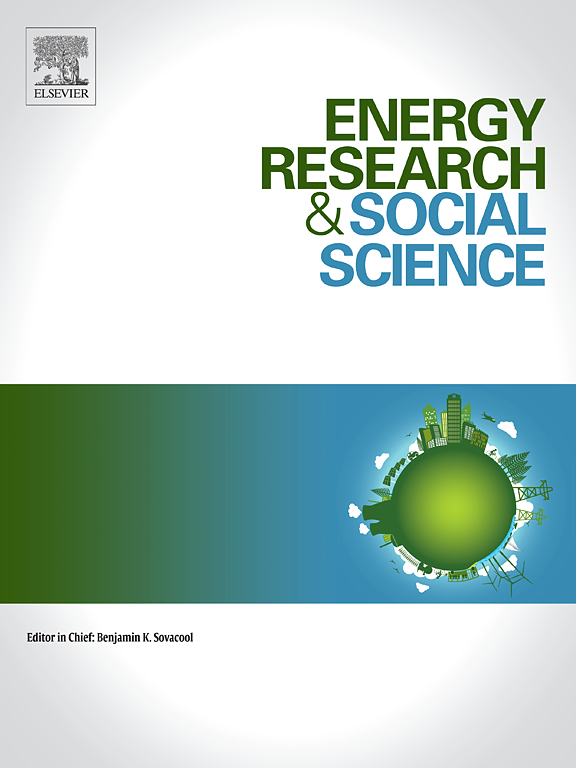在石油资源丰富的国家引导太阳能转型:伊朗合作治理的基于网络的研究
IF 7.4
2区 经济学
Q1 ENVIRONMENTAL STUDIES
引用次数: 0
摘要
能源需求的增加、全球变暖以及化石燃料消费带来的经济后果促使各国政府朝着实现净零排放目标迈进。在这种背景下,可再生能源(RE)的发展至关重要,特别是在中东和北非地区的石油资源丰富的国家。本研究的重点是伊朗,考察协作治理作为向太阳能(SE)过渡的关键驱动因素。能源转型本质上是一个复杂和多方面的过程,充满了许多挑战,需要利益相关者的有效合作。本研究采用双模式社会网络分析(SNA)来分析伊朗经济转型中的协同治理结构,并将现有障碍与相关利益相关者联系起来。通过全面的文献综述、半结构化访谈、专家调查和文献分析,精心收集数据。由此形成的网络包括11个类别的39个利益相关者,5个类别中的16个关键障碍,以及它们之间的92个相互联系。此外,还确定了协作治理的12个基本挑战,表明了制度上的弱点和政策层面的不一致。利用互动模型——特别是挑战-利益相关者和挑战-障碍模型——深入研究了每个利益相关者在应对挑战中的作用及其对现有障碍的影响。研究结果揭示了东南转型中权力失衡、缺乏合作、各级治理规则和法规分散、缺乏协调和制度一致性以及行政腐败对资源配置的影响等挑战。这项研究为政策制定者设计有针对性的干预措施提供了可行的见解,这些干预措施可以加强合作治理,促进伊朗更有效地向东南转型。本文章由计算机程序翻译,如有差异,请以英文原文为准。
Navigating solar energy transitions in oil-rich countries: A network-based study of collaborative governance in Iran
Increased energy demand, global warming, and the economic ramifications of fossil fuel consumption have propelled governments toward achieving net-zero emission targets. In this context, renewable energy (RE) development is paramount, particularly in oil-rich nations within the Middle East and North Africa region. This research focuses on Iran, examining collaborative governance as a pivotal driver in the transition to solar energy (SE). The energy transition is an inherently complex and multifaceted process, fraught with numerous challenges, necessitating effective stakeholder collaboration. This study employs two-mode social network analysis (SNA) to analyze the structure of collaborative governance in Iran's SE transition and to link existing obstacles to relevant stakeholders. Data were meticulously gathered through a comprehensive literature review, semi-structured interviews, expert surveys, and document analysis. The resulting network comprises 39 stakeholders across 11 categories, 16 key barriers within 5 classifications, and 92 interconnections among them. Furthermore, 12 fundamental challenges to collaborative governance were identified, indicative of institutional weaknesses and policy-level inconsistencies. Utilizing interactive models—specifically, challenge–stakeholder and challenge–barrier models—the role of each stakeholder in addressing challenges and their impact on existing barriers was thoroughly investigated. Findings reveal challenges such as power imbalance, lack of cooperation, fragmented rules and regulations across levels of governance, lack of coordination and institutional alignment, and the impact of administrative corruption on resource allocation in the SE transition. This research provides actionable insights for policymakers to design targeted interventions that strengthen collaborative governance and facilitate a more effective transition to SE in Iran.
求助全文
通过发布文献求助,成功后即可免费获取论文全文。
去求助
来源期刊

Energy Research & Social Science
ENVIRONMENTAL STUDIES-
CiteScore
14.00
自引率
16.40%
发文量
441
审稿时长
55 days
期刊介绍:
Energy Research & Social Science (ERSS) is a peer-reviewed international journal that publishes original research and review articles examining the relationship between energy systems and society. ERSS covers a range of topics revolving around the intersection of energy technologies, fuels, and resources on one side and social processes and influences - including communities of energy users, people affected by energy production, social institutions, customs, traditions, behaviors, and policies - on the other. Put another way, ERSS investigates the social system surrounding energy technology and hardware. ERSS is relevant for energy practitioners, researchers interested in the social aspects of energy production or use, and policymakers.
Energy Research & Social Science (ERSS) provides an interdisciplinary forum to discuss how social and technical issues related to energy production and consumption interact. Energy production, distribution, and consumption all have both technical and human components, and the latter involves the human causes and consequences of energy-related activities and processes as well as social structures that shape how people interact with energy systems. Energy analysis, therefore, needs to look beyond the dimensions of technology and economics to include these social and human elements.
 求助内容:
求助内容: 应助结果提醒方式:
应助结果提醒方式:


